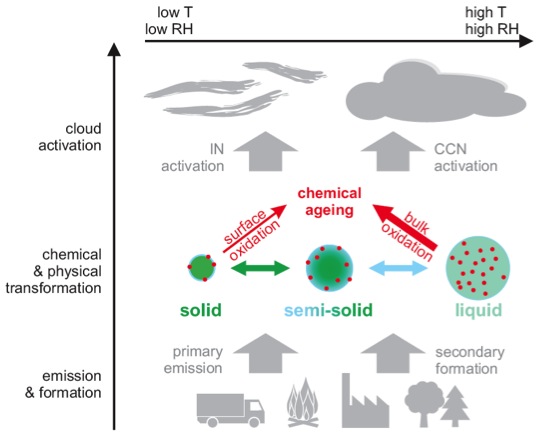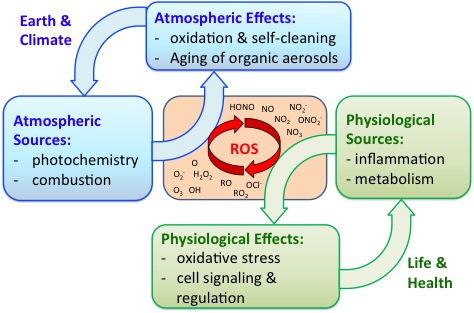Research topics:
- Gas uptake, formation, evolution and partitioning of organic aerosols
 (Shiraiwa et al., PNAS, 2011) |
Organic aerosols
can adopt liquid, semi-solid, or solid phase states, depending on
chemical composition and environmental conditions. Using the kinetic multi-layer models of surface and bulk chemistry and
gas-particle interactions (KM-SUB/KM-GAP), we study how the interplay
of phase state, water content, and thermodynamic mixing affects
formation, partitioning, and chemical transformation of secondary
organic aerosols. |

- Multiphase chemical processes at skin and indoor air quality
Heterogeneous reactions of ozone with
human skin lipids and indoor surfaces can lead to generation of
semi-volatile compounds and subsequent SOA formation, strongly
affecting chemical composition and distribution in indoor environments.
We developed the kinetic multi-layer model of multiphase chemistry at
the skin to quantify skin ozonolysis products in indoor environments.
PI is leading a new modeling consortium of chemistry in indoor
environments (MOCCIE), which aims at developing comprehensive and
integrated physicochemical models that include a realistic
representation of gas, aerosol and surface chemistry and how occupants,
indoor activities and buildings influence indoor chemical processes. We
assess gaps in our fundamental understanding of indoor chemistry
focusing on impacts of reactions of indoor oxidants with skin as well
as oxidation of volatile organic compounds emitted by cleaning
activities. Please see the MOCCIE project HP.
- Reactive Oxygen Species/Intermediates (ROS/ROI) and their health effects

(Pöschl & Shiraiwa, Chem. Rev., 2015)
Funding:
We are very grateful to the followng funding agencies for supporting our research.
• National Science Foundation (NSF), "1808125
Multiphase Chemistry of Reactive Oxygen Species and Free Radicals in Secondary Organic Aerosols", CHE-1808125, 2018 - 2021, PI: Manabu Shiraiwa.
• National Science Foundation (NSF), "CAREER: Interplay of Particle Phase State and Thermodynamic Mixing in Secondary Organic Aerosol Formation and Partitioning", AGS-1654104, 2017 - 2022, PI: Manabu Shiraiwa.
• Department of Energy (DOE), DE-SC0018349, "Impacts of phase state and water content on secondary organic aerosol formation and partitioning", 2017 - 2020, PI: Manabu Shiraiwa, co-PI: James Smith, Ann Marie Carlton, Sergey Nizkorodov.
• Alfred P. Sloan Foundation, "MOdelling Consortium for Chemistry of Indoor Environments (MOCCIE)", No. G-2017-9796, 07/01/2017 – 06/30/2019, PI: Manabu Shiraiwa, co-PI: Nicola Carslaw.
• Pacific Northwest National Laboratory (PNNL), Environmental Molecular Sciences Laboratory (EMSL), "Effect of Condensed-Phase Photochemical Reactions on Viscosity and Volatility of Organic Aerosols", No. 49352, 2016 - 2018, PI: Manabu Shiraiwa, co-PI: Sergey Nizkorodov.
• Japan Society for the Promotion of Science (JSPS), Grant-in-Aid for challenging Exploratory Research, Quantification of free radicals and reactive oxygen species in atmospheric aerosol particles, No. 16K12582, 2016 - 2019, PI: Manabu Shiraiwa, co-PI: Michihiro Mochida.